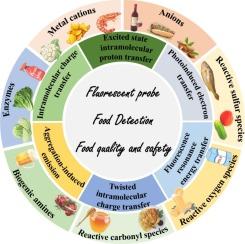用于食品检测的小分子荧光探针的最新设计策略和应用
IF 20.3
1区 化学
Q1 CHEMISTRY, INORGANIC & NUCLEAR
引用次数: 0
摘要
食品安全问题已成为社会关注的焦点,与消费者的健康息息相关。因此,开发高效、准确、便捷的新型食品检测技术对保障食品安全和公众健康具有重要意义。近年来,小分子荧光探针因其灵敏度高、识别特异性强、操作简便等特点被广泛应用于食品检测领域。本文综述了近年来小分子荧光探针在食品检测中的应用,主要包括金属离子、活性硫、活性氧、活性羰基、生物胺和酶等分析物的检测。本文还探讨了食品检测荧光探针目前面临的挑战和未来的研究方向,为后续探针的开发提供参考。本文章由计算机程序翻译,如有差异,请以英文原文为准。

Recent design strategies and applications of small molecule fluorescent probes for food detection
Food safety issues have become society's focus and are closely related to consumer health. Therefore, the development of novel food testing technologies that are efficient, accurate, and convenient is of important significance to ensure food safety and public health. The small molecule fluorescent probes have been widely used in food detection because of their high sensitivity, high specificity of recognition, and simplicity of operation in recent years. In this paper, the application of small molecule fluorescent probes in food detection in recent years was reviewed, mainly including the detection of analytes such as metal ions, reactive sulfur species, reactive oxygen species, reactive carbonyl species, biogenic amines, and enzymes. This paper also discusses the current challenges and future research directions of fluorescent probes for food detection, providing a reference for the development of subsequent probes.
求助全文
通过发布文献求助,成功后即可免费获取论文全文。
去求助
来源期刊

Coordination Chemistry Reviews
化学-无机化学与核化学
CiteScore
34.30
自引率
5.30%
发文量
457
审稿时长
54 days
期刊介绍:
Coordination Chemistry Reviews offers rapid publication of review articles on current and significant topics in coordination chemistry, encompassing organometallic, supramolecular, theoretical, and bioinorganic chemistry. It also covers catalysis, materials chemistry, and metal-organic frameworks from a coordination chemistry perspective. Reviews summarize recent developments or discuss specific techniques, welcoming contributions from both established and emerging researchers.
The journal releases special issues on timely subjects, including those featuring contributions from specific regions or conferences. Occasional full-length book articles are also featured. Additionally, special volumes cover annual reviews of main group chemistry, transition metal group chemistry, and organometallic chemistry. These comprehensive reviews are vital resources for those engaged in coordination chemistry, further establishing Coordination Chemistry Reviews as a hub for insightful surveys in inorganic and physical inorganic chemistry.
 求助内容:
求助内容: 应助结果提醒方式:
应助结果提醒方式:


